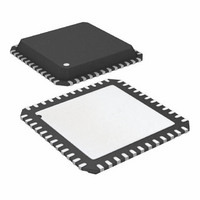ADUC7034BCPZ-RL Analog Devices Inc, ADUC7034BCPZ-RL Datasheet - Page 19

ADUC7034BCPZ-RL
Manufacturer Part Number
ADUC7034BCPZ-RL
Description
IC,Battery Management,LLCC,48PIN,PLASTIC
Manufacturer
Analog Devices Inc
Series
MicroConverter® ADuC7xxxr
Datasheet
1.ADUC7034BCPZ-RL.pdf
(136 pages)
Specifications of ADUC7034BCPZ-RL
Core Processor
ARM7
Core Size
16/32-Bit
Speed
20.48MHz
Connectivity
LIN, SPI, UART/USART
Peripherals
POR, PSM, Temp Sensor, WDT
Number Of I /o
9
Program Memory Size
32KB (32K x 8)
Program Memory Type
FLASH
Ram Size
4K x 8
Voltage - Supply (vcc/vdd)
3.5 V ~ 18 V
Data Converters
A/D 2x16b
Oscillator Type
Internal
Operating Temperature
-40°C ~ 115°C
Package / Case
48-LFCSP
Lead Free Status / RoHS Status
Lead free / RoHS Compliant
Eeprom Size
-
Lead Free Status / RoHS Status
Lead free / RoHS Compliant
TERMINOLOGY
Conversion Rate
The conversion rate specifies the rate at which an output result
is available from the ADC after the ADC has settled.
The Σ-Δ conversion techniques used on this part mean that
while the ADC front-end signal is oversampled at a relatively
high sample rate, a subsequent digital filter is used to decimate
the output, providing a valid 16-bit data conversion result for
output rates from 1 Hz to 8 kHz.
Note that when software switches from one input to another on
the same ADC, the digital filter must first be cleared and then
allowed to average a new result. Depending on the configuration
of the ADC and the type of filter, this may require multiple
conversion cycles.
Integral Nonlinearity (INL)
INL is the maximum deviation of any code from a straight line
passing through the endpoints of the transfer function. The end-
points of the transfer function are zero scale, a point ½ LSB
below the first code transition, and full scale, a point ½ LSB
above the last code transition (111 ... 110 to 111 ... 111).
The error is expressed as a percentage of full scale.
No Missing Codes
No missing codes is a measure of the differential nonlinearity
of the ADC. The error is expressed in bits (as 2
no missing codes) and specifies the number of codes (ADC
results) that are guaranteed to occur through the full ADC
input range.
Offset Error
Offset error is the deviation of the first code transition ADC
input voltage from the ideal first code transition.
N
bits, where N is
Rev. B | Page 19 of 136
Offset Error Drift
Offset error drift is the variation in absolute offset error with
respect to temperature. This error is expressed as LSBs per
degrees Celsius.
Gain Error
Gain error is a measure of the span error of the ADC. It is a
measure of the difference between the measured and the ideal
span between any two points in the transfer function.
Output Noise
The output noise is specified as the standard deviation (that is,
1 × Σ) of the distribution of ADC output codes that are collected
when the ADC input voltage is at a dc voltage. It is expressed
as μV rms. The output, or rms noise, can be used to calculate
the effective resolution of the ADC as defined by the following
equation:
where Effective Resolution is expressed in bits.
The peak-to-peak noise is defined as the deviation of codes that
fall within 6.6 × Σ of the distribution of ADC output codes that
are collected when the ADC input voltage is at dc. The peak-to-
peak noise is therefore calculated as 6.6 times the rms noise.
The peak-to-peak noise can be used to calculate the ADC
(noise-free code) resolution for which there is no code flicker
within a 6.6 × Σ limit as defined by the following equation:
where Noise-Free Code Resolution is expressed in bits.
Effective Resolution = log
Noise-Free Code Resolution = log
to-Peak Noise)
2
(Full-Scale Range/RMS Noise)
2
(Full-Scale Range/Peak-
ADuC7034












